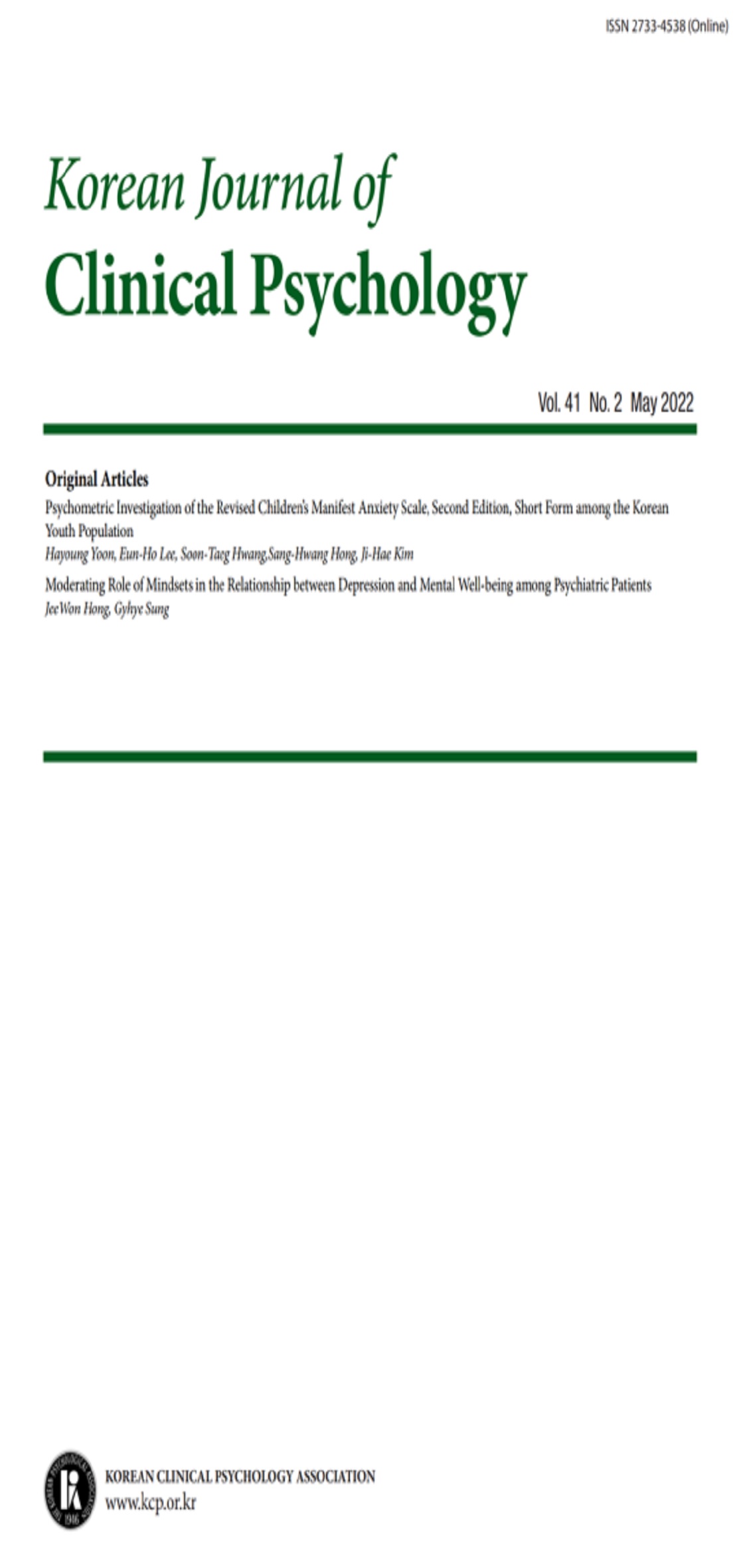open access
메뉴
open access
메뉴 E-ISSN : 2733-4538
E-ISSN : 2733-4538
본 연구의 목적은 EMDR(eye movement desensitization and reprocessing)의 구성요소 중 하나인 양측성 안구운동이 상태 불안 및 작업기억 과제 수행에 어떠한 영향을 미치는지 검증하는 것이었다. 한국판 시험불안 척도를 사용해서 시험불안이 높은 41명의 대학생을 선별하여 처치집단(N=19)과 통제집단(N=21)에 무작위 할당하였다. 참가자들에게 산수문제를 풀도록 하여 불안을 유발한 후, 처치집단과 통제집단에 양측성 안구운동과 안구고정을 각각 처치하였다. 참가자들은 처치 전후에 상태불안척도를 작성하였고, 마지막으로 3-back 과제를 수행하였다. 연구 결과, 처치집단은 통제집단보다 상태불안이 저하되었으며, 이는 수평 안구운동이 상태불안을 감소시키는데 도움이 될 수 있음을 시사한다. 그러나 3-back 과제 수행에서는 두 집단 간에 유의한 차이가 나타나지 않았다. 본 연구의 제한점과 후속 연구에 대한 제언이 논의되었다.
The purpose of this study was to examine how horizontal eye movements, a component of the EMDR(eye movement desensitization and reprocessing), influence the level of state anxiety and performance on working memory task. Among college students with higher average score on Test Anxiety Inventory-Korea, 41 subjects were randomly assigned to the horizontal eye movement (n=19) and the eye fixed group (n=21). As a way to trigger state anxiety, the participants were subjected to a mathematical examination prior to the assignment. State anxiety was measured on both pre- and post-treatment. Finally, participants performed a 3-back task. According to the results, the horizontal eye movement group showed a more significant decrease in state anxiety than the eye fixed group, suggesting that horizontal eye movement could be helpful in reducing the level of anxiety. However, no significant difference in the accuracy rate of 3-back task performance was observed between the two groups. Limitations of the current study and suggestions for future research were discussed.
김대호 (2005). 외상후 스트레스 장애에 대한 안구운동 민감소실 및 재처리 요법. 대한신경정신의학회, 44(2), 147-151.
김문주 (1990). 시험불안도와 그에 영향을 미치는 사회심리적 요인에 관한 연구-시험불안 측정을 위한 도구개발 과정을 중심으로. 한국교육심리학회, 4(1), 91-110.
염태호, 박영숙, 오경자, 김정규, 이영호 (1992). K-WAIS 실시요강. 서울: 한국가이던스.
이수정, 민윤기, 김보성, 최미현, 양재웅, 최진승 외. (2009). 각성 수준에 따른 3-back 과제 수행 능력의 차이. 감성과학, 12(4), 373-380.
한덕웅, 이장호, 전겸구 (1996). Spielberger의 상태-특성 불안검사 Y형의 개발. 한국심리학회지: 건강, 1(1), 1-14.
Baddeley, A. D. (1986). Working memory. London: Oxford University Press.
Baddeley, A. D. (2000a). The episodic buffer: A new component of working memory? Trends in Cognitive Sciences, 4(11), 417-423.
Boudewyns, P. A., Stwertka, S. A., Hyer, L. A., Albert, J. W., & Sperr, E. V. (1993). Eye movement desensitization and reprocessing: A pilot study. Behavior Therapist, 16, 30-33.
Darke, S. (1988). Anxiety and working capacity. Cognition and Emotion, 2, 145-154.
Davidson, P. R., & Parker, K. C. H. (2001). Eye movement desensitization and reprocessing (EMDR): a meta-analysis. Journal of Consulting and Clinical Psychology, 69, 305-316.
Devilly, G. J., Ono, M., & Lohr, J. M. (2014). The use of meta-analytic software to derive hypotheses for EMDR. Journal of Behavior Therapy and Experimental Psychiatry, 45, 223- 225.
Eysenk, M. W., & Calvo, M. G. (1992). Anxiety and performance: The processing efficiency theory. Cognitive and Emotion, 6, 409-434.
Eysenck, H. J., & Eysenk, M. W. (1985). Personality and individual difference. New York: Plenum Press.
Geen, R. G. (1985). Evaluation appreciation and response withholding in solution of anagrams. Personality and Individual Differences, 6, 293- 298.
Gosselin, P., & Matthews, W. J. (1995). Eye movement desensitization and reprocessing in the treatment of test anxiety: a study of the effects of expectancy and eye movement. Journal of Behavior Therapy & Experimental Psychiatry, 26, 331-337.
Lee, C. W., & Cuijpers, P. (2013). A meta-analysis of the contribution of eye movements in processing emotional memories. Behavioural Therapy and Experimental Psychiatry, 44, 231- 239.
Maxfield, L., & Melnyk, W. T. (2000). Single session treatment of test anxiety with eye movement desensitization and reprocessing (EMDR). International Journal of Stress Management, 7(2), 87-101.
Shapiro, F. (1987). Efficacy of the Eye Movement Desensitization(EMD) Procedure in the treatment of traumatic memories. Journal of Traumatic Stress, 2, 199-223.
Smith, M. E., McEvoy, L. K., & Gevins, A. (1999). Neurophysiological indices of strategy development and skill acquisition. Cognitive Brain Research, 7, 389-404.
Spielberger, C. D. (1983). Manual for the State-Trait Anxiety Inventory: STAI(Form Y). Palo Alto, CA: Consulting Psychologists Press.
Spielberger, C. D., Anton, W. D., Gonzalez, H. P., & Taylor, C. J. (1980). Preliminary professional manual for the Test Anxiety Inventory. Palo Alto, CA: Consulting Psychologists Press.
Mowbray, T. (2012). Working memory, test anxiety and effective interventions: A review. The Australian Educational and Developmental Psychologist, 29, 141-156.
Muris, P., Merchelbach., H., van Haaften, H., & Mayer, B. (1997). Eye movement desensitization and reprocessing(EMDR) versus exposure in vivo: A single session crossover study of spider phobic children. British Journal of psychiatry, 171, 82-86.
